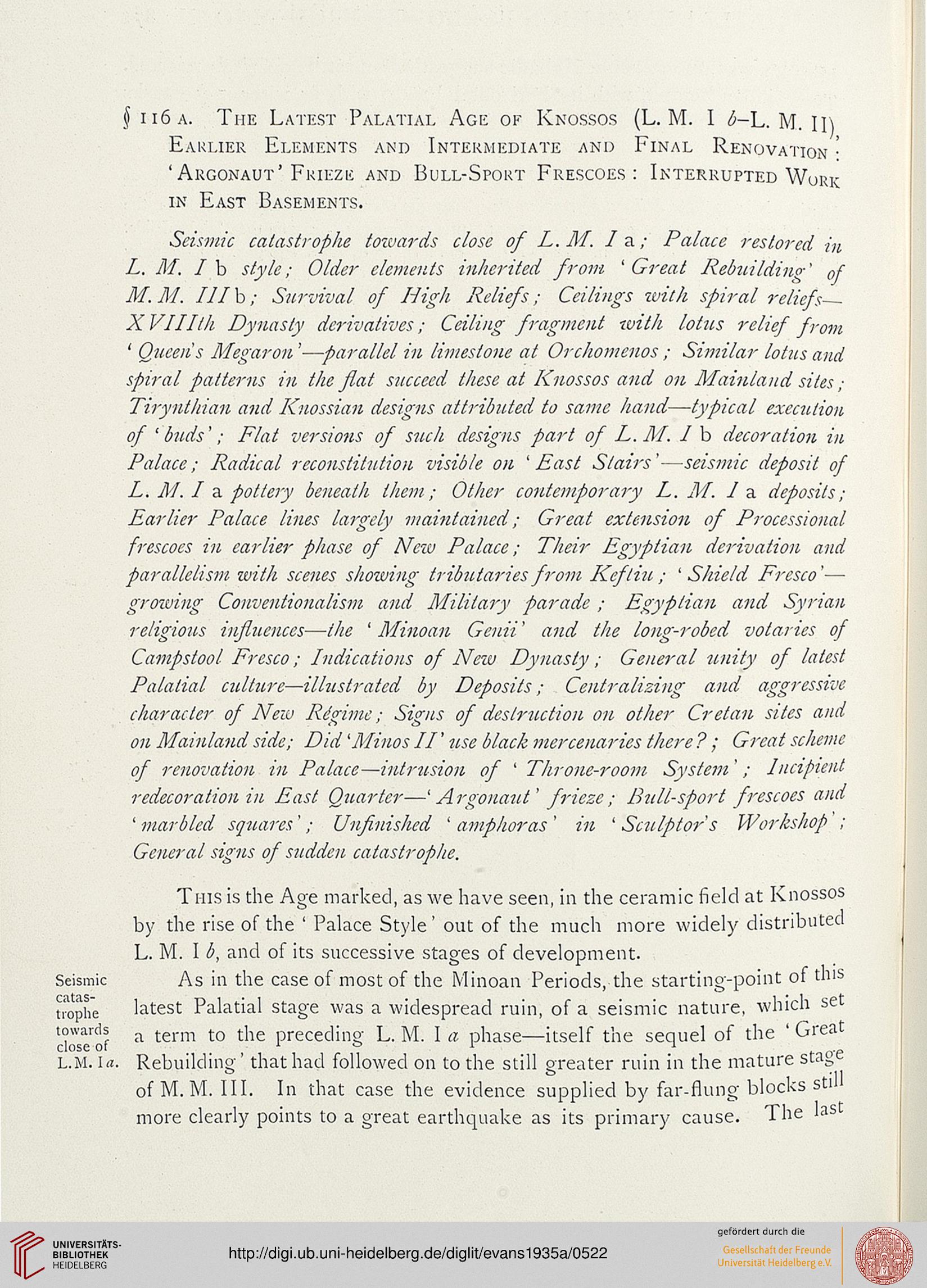<Sii6a. The Latest Palatial Age of Knossos (L. M. I tf-L. M. IN
Earlier Elements and Intermediate and Final Renovation ■
'Argonaut'Frieze and Bull-Sport Frescoes: Interrupted Work
in East Basements.
Seismic catastrophe towards close of L.M. Is.; Palace restored in
L, M. lb style; Older elements inherited from 'Great Rebuilding' of
M. M. Ill b; Survival of High Reliefs; Ceilings with spiral reliefs__
X VII IIh Dynasty derivatives; Ceiling fragment with, lotus relief from
' Queen's Megaron'—parallel in limestone at Orchomenos ; Similar lotus and
spiral patterns in the fiat succeed these at Knossos and on Mainland sites •
Tirynthian and Kuossian designs attributed to same hand—typical execution
of ' buds'; Flat versions of such designs part of L. M. I b decoration in
Palace; Radical reconslitulion visible on 'East Stairs'—seismic deposit of
L. M. I a pottery beneath them; Other contemporary L.M. I a deposits;
Earlier Palace lines largely maintained; Great extension of Processional
frescoes in earlier phase of New Palace; Their Egyptian derivation and
parallelism with scenes showing tributaries from Kef tin ; 'Shield Fresco'—
growing Conventionalism and Military parade ; Egyptian and Syrian
religions influences—the ' Minoan Genii' and the long-robed votaries of
Campstool Fresco; Indications of New Dynasty; General unity of latest
Palatial culture—illustrated by Deposits; Centralizing and aggressive
character of New Rdgime; Signs of destruction on other Cretan sites and
on Mainland side; Did 'Minos II' use black mercenaries there ? ; Great scheme
of renovation in Palace—intrusion of ' Throne-room System'; Incipient
redecoration in East Quarter—' Argonaut' frieze ; Bull-sport frescoes and
' marbled squares'; Unfinished ' amphoras ' in ' Sculptor's Workshop ;
General signs of sudden catastrophe.
This is the Age marked, as we have seen, in the ceramic field at Knossos
by the rise of the ' Palace Style' out of the much more widely distributed
L. M. I b, and of its successive stages of development.
Seismic As in the case of most of the Minoan Periods, the starting-point of this
trophe latest Palatial stage was a widespread ruin, of a seismic nature, which set
towards a term t0 the preceding L. M. I a phase—itself the sequel of the ' Great
L.M. la. Rebuilding' that had followed on to the still greater ruin in the mature stage
ofM. M. III. In that case the evidence supplied by far-flung blocks still
more clearly points to a great earthquake as its primary cause. The «s
Earlier Elements and Intermediate and Final Renovation ■
'Argonaut'Frieze and Bull-Sport Frescoes: Interrupted Work
in East Basements.
Seismic catastrophe towards close of L.M. Is.; Palace restored in
L, M. lb style; Older elements inherited from 'Great Rebuilding' of
M. M. Ill b; Survival of High Reliefs; Ceilings with spiral reliefs__
X VII IIh Dynasty derivatives; Ceiling fragment with, lotus relief from
' Queen's Megaron'—parallel in limestone at Orchomenos ; Similar lotus and
spiral patterns in the fiat succeed these at Knossos and on Mainland sites •
Tirynthian and Kuossian designs attributed to same hand—typical execution
of ' buds'; Flat versions of such designs part of L. M. I b decoration in
Palace; Radical reconslitulion visible on 'East Stairs'—seismic deposit of
L. M. I a pottery beneath them; Other contemporary L.M. I a deposits;
Earlier Palace lines largely maintained; Great extension of Processional
frescoes in earlier phase of New Palace; Their Egyptian derivation and
parallelism with scenes showing tributaries from Kef tin ; 'Shield Fresco'—
growing Conventionalism and Military parade ; Egyptian and Syrian
religions influences—the ' Minoan Genii' and the long-robed votaries of
Campstool Fresco; Indications of New Dynasty; General unity of latest
Palatial culture—illustrated by Deposits; Centralizing and aggressive
character of New Rdgime; Signs of destruction on other Cretan sites and
on Mainland side; Did 'Minos II' use black mercenaries there ? ; Great scheme
of renovation in Palace—intrusion of ' Throne-room System'; Incipient
redecoration in East Quarter—' Argonaut' frieze ; Bull-sport frescoes and
' marbled squares'; Unfinished ' amphoras ' in ' Sculptor's Workshop ;
General signs of sudden catastrophe.
This is the Age marked, as we have seen, in the ceramic field at Knossos
by the rise of the ' Palace Style' out of the much more widely distributed
L. M. I b, and of its successive stages of development.
Seismic As in the case of most of the Minoan Periods, the starting-point of this
trophe latest Palatial stage was a widespread ruin, of a seismic nature, which set
towards a term t0 the preceding L. M. I a phase—itself the sequel of the ' Great
L.M. la. Rebuilding' that had followed on to the still greater ruin in the mature stage
ofM. M. III. In that case the evidence supplied by far-flung blocks still
more clearly points to a great earthquake as its primary cause. The «s





